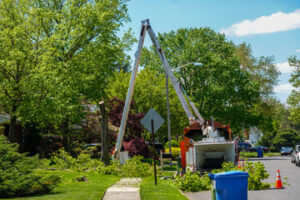Tree Removal Baltimore services are a must when a tree becomes unhealthy or if it poses a threat to the surrounding area. They keep property safe and clean by removing dead trees, pruning overhanging branches, and removing stumps.

When considering tree removal, make sure that your property is free of breakable items and that there’s ample space for the service to park their equipment. This will help speed up the process.
A tree is an asset to any property, providing shade and boosting the aesthetic appeal of outdoor spaces. However, as trees age and become unhealthy, they may need to be removed. Whether this is due to safety concerns or simply to make room for new growth, the process requires careful attention and precision. This is why it is important to hire a reputable tree removal company that can handle the task safely and efficiently.
Before starting the process, a qualified arborist will assess the situation and determine the best course of action for the tree. This may include removing the entire tree or pruning and limbing it to reduce its size. A good arborist will also provide a detailed estimate and work with the client to accommodate their budget.
To ensure safety during the removal process, the worker should use the proper tools and equipment. These tools include a chainsaw, climbing ropes, and a safety harness. Using these tools properly will prevent injuries and minimize damage to the surrounding area. Additionally, workers should wear protective gear, such as gloves, eye and ear protection, and helmets. It is also important to follow proper cutting techniques to avoid injury and ensure that the tree falls in the correct direction.
During the removal process, the tree is cut in sections until it has reached the ground. The branches will then be secured with ropes to prevent them from falling into power lines or other buildings. In some cases, the trunk will be cut into pieces if it is too large to remove in one piece. In these cases, the pieces will be transported to a processing site where they will be shredded and disposed of.
Once the tree has been removed, the stump will need to be ground or chemically treated. This will prevent it from growing back and causing further problems on your property. After the removal of a tree, it is also important to clean up the area. This includes removing any debris, such as fallen branches or leaves, and arranging for their disposal.
Environmental Impact
Whether due to health issues, safety concerns, or the need for space for development, tree removal is a serious matter that requires careful consideration. Arborists and environmentalists work together to weigh the ecological impact of a removal against the necessity for one. Before a chainsaw touches bark, an inspection and assessment by certified arborists is crucial. This will help determine the condition of the tree and the best course of action.
Trees are vital for the environment and contribute to our quality of life. They can lower temperatures, protect soil, reduce erosion, and provide habitat for wildlife. In addition, they improve air quality and can reduce noise pollution in urban areas. They also help to remove pollutants from the air, such as particulates and ozone. They can even increase the nutrient content of soil, making it more nutritious for plants to grow.
However, a single tree’s impact can be difficult to measure. The effects of tree loss may be more pronounced in some contexts than others, and they can vary across city neighborhoods. This is because urban ecosystems are complex and highly influenced by local social and economic factors. In order to estimate the effects of tree loss, long-term studies with multiple replications are required.
In addition, environmental impacts can be caused by the process of tree removal itself. The physical disturbance caused by the act of removing a tree can confound experimental results, and it is important to choose a service that is committed to environmentally responsible practices. These include selective cutting, responsible wood repurposing, and a commitment to replanting.
A standardized method of measuring key parameters in the experiment would also be beneficial. This could help minimize the potential for bias or a difference between treatment and control plots, especially in a densely-populated urban landscape with a variety of different land uses. Another potential solution is to block treatment and control plots within larger landscape units that are managed by the same municipal agency. This can reduce the possibility of interference between replicates, and it may also help to mitigate legacy effects at the study site.
Regulations
In some areas, there are specific regulations that apply to tree removal. In Tallahassee, for example, the city requires that anyone who wants to cut down a tree that is more than three and a half feet in circumference or taller must obtain a permit. In addition, the city requires that a professional tree service company take care of any hazardous waste created by the removal process.
There are also laws governing where trees can be planted and where they cannot. Generally, utility companies have strict policies about the distance from the ground that a tree should be to the power lines. These policies are often based on the type of tree and its height at maturity. For this reason, it is important to plant a tree far away from utility lines.
Neither New Mexico nor its capital city of Albuquerque have any special regulations for private property owners when it comes to removing or trimming trees on their property. The responsibility for the health and care of any tree on a private residence is the owner’s, so financial compensation for a dying or hazard-prone tree falls solely on the homeowner.
Other cities, such as Boston and Albany, have regulations governing the placement and removal of trees on private property. Boston’s law requires that anyone who removes a tree from their property must submit a permit application and provide an arborist report. The city will then review the permit application and approve it if it meets the requirements. Albany has similar rules, with the director of development services being able to enter private property to remove any tree that is in danger of falling onto public pavement or sidewalks.
In some cases, the issuance of a permit to remove a tree may depend on the tree’s species and whether it is near a protected area or natural resource district. Some of the requirements for obtaining a permit include a site plan, tree survey, and a certified arborist report. Additionally, the application must contain a detailed description of the tree(s) that are to be removed. In some cases, the application will also require the approval of the local fire chief.
Cost
There are many factors that influence the cost of tree removal. The size of the tree is one factor, as trees that are smaller than 30 feet typically cost less to remove than those that are more than 60 feet tall. The condition of the tree is another factor, as dead or diseased trees are more difficult and time-consuming to remove than healthy ones. Additionally, if the tree is located close to homes or power lines, it may require extra safety precautions and specialized equipment, which will increase the price.
The type of wood the tree is made of also plays a role in the cost of removal. Harder woods, such as oak, typically cost more to remove than softwoods, like pine. In addition, the height of the tree impacts the price, as larger trees are more expensive to remove than small ones. Other considerations include whether the tree is located near roads or other structures, and how easily a professional can access it.
In some cases, it is possible to transplant a tree instead of removing it. This option can save you money and help you create more attractive landscaping on your property. However, this service is more expensive than simple cutting and usually requires a special crane or other heavy machinery. In addition, it may take up to a year for the transplanted tree to grow to full size.
There are many additional costs associated with tree removal, such as debris cleanup and disposal. Often, these services are included in the initial quote but you should ask for an itemized list to be sure. In addition, you should consider the cost of gas, as arborists use their vehicles to transport equipment and haul away debris. Lastly, you should also be aware of any local laws or environmental regulations that may affect the price. Having an understanding of the different factors that affect the cost of tree removal will help you get the best value for your money. Be sure to compare quotes from several companies and choose a company that has experience in removing large trees.



